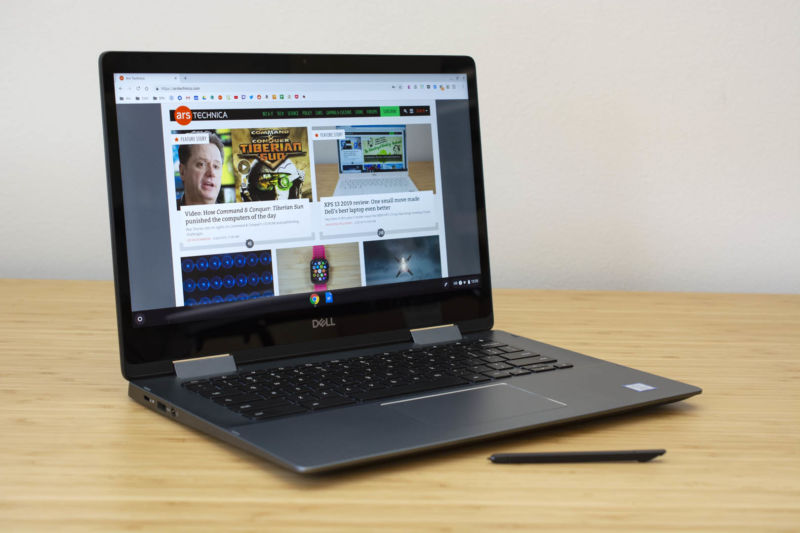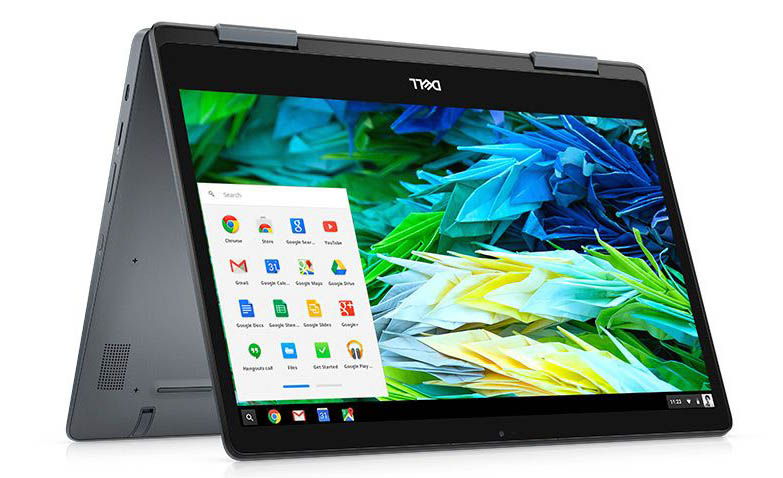
Dell is no stranger to Chromebooks. In fact, the Dell Chromebook 11 is our current favorite Chromebook for students with its simple, durable black frame and attractive price tag. Most of Dell's Chrome OS notebooks share those useful traits, so when the company stepped out of the box and debuted its $599 Inspiron Chromebook 14 at the end of last year, my interested was piqued.
This device isn't the penny-pinching plastic laptop that so many think of when they hear "Chromebook." Instead, it follows the new trend of high-end Chrome OS devices designed to offer alternatives to Google's own $999 Pixelbook. Since Dell already makes numerous Chromebooks that are generally solid, I was curious to see how the company would fare making a premium Chromebook. These are niche devices that have to tick certain boxes to even come within the same range as Google's own Chrome OS devices, so I spent one day with the Inspiron Chromebook 14 to see just how premium the convertible actually is and if it's worth the extra money.
Design
The heft of the Inspiron Chromebook 14 surprised me when I first heaved it out of the box. It weighs just about four pounds, making it noticeably heavy when compared to other Chromebooks. Even our current favorite premium Chromebook, the Acer Chromebook Spin 13, doesn't weigh that much. Chrome OS is a "light" operating system that's designed to run nimbly on scant hardware, so I question why any Chromebook would be so heavy.
| Specs at a glance: Dell Inspiron Chromebook 14 | |
|---|---|
| Screen | 14-inch 1920 x 1080 LED IPS touchscreen |
| OS | Chrome OS |
| CPU | Intel Core i3-8130U |
| RAM | 4GB |
| HDD | 128GB |
| GPU | Intel UHD Graphics 620 |
| Networking | Dual Band Wireless AC 7265 (802.11ac) 2x2, Bluetooth 4.2 |
| Ports | 2 x USB-C 3.1 ports, 1 x USB-A port, 1 x microSD card slot, 1 x headphone/mic jack |
| Size | 12.95 x 9.1 x 0.70 inches |
| Weight | 3.9 pounds |
| Battery | 56Whr |
| Starting price | $599 |
| Price as reviewed | $599 |
| Other perks | Included stylus built into chassis |

Dell Inspiron Chromebook 14
However, the 14 is undoubtably a well-made convertible. The all-aluminum chassis is sturdy and doesn't bend or give under pressure. Its thick metal hinges support the 14-inch FHD screen no matter which mode it sits in, and I appreciate how smoothly the hinges move when I switch from tablet to laptop mode and vise versa.
But the touchscreen has a 16:9 aspect ratio, which doesn't lend itself to tablet use in general. It'll be good for watching widescreen films and when consuming other forms of entertainment, but it's not the best for productivity regardless of whether you're using the trackpad or your fingers as the main input method.
I was also struck by how much empty space there is on the Inspiron Chromebook 14. Chunky black bezels surround the display, including a large chin on its bottom. More than one inch of space hugs either side of the keyboard as well, and the palm rests seem massive. I can forgive the bezels more than the chassis space, because, as a convertible, users will grip those areas when using the Chromebook in tablet mode.
But there's just too much empty space in the keyboard and trackpad area. Dell didn't even put the speakers on the sides of the keyboard to fill up that space. Instead, the grille sits on the bottom of the notebook and will always pump out muffled sound if you're using the device in laptop mode on your lap. Thankfully, the keyboard itself is very comfortable and quiet. Dell could have even spread the keys out more to fill the space or added a dedicated Caps Lock key (something that most Chromebooks lack as it's replaced by the search/launcher key).
As far as the trackpad goes, it's a decent size, but Dell could have easily made it a half-inch or so bigger, following the trend of extra-large trackpads living on most premium laptops. I also had some strange scrolling difficulties while using this trackpad: sometimes my double-finger gesture to scroll down on a page didn't work. It happened mostly in Chrome browser tabs, and a quick up-and-down scroll would often fix it—but it was annoying nonetheless.
The convertible's edges are equally as sparse as its keyboard and trackpad area. On the sides, you'll find two USB-C 3.1 ports, one USB-A port, one microSD card reader, and one headphone jack. While that's pretty standard, especially for Chromebooks, it seems like Dell had the space to include another USB-A port but it chose not to do so.
I may be harping too much on space, but overall the Inspiron Chromebook 14 looks and feels too large to me. It has the heft and build of a 15-inch device, but with a screen, keyboard and trackpad, and port array of a smaller laptop. The build quality may be stellar, but it won't mean much if it gets in the way of portability and practicality.
That large chassis does come in handy for at least one thing: housing an included stylus. On the bottom-right corner of the chassis is a tiny stylus that slides out with a simple tug from your finger. Like its counterpart on the Acer Chromebook Spin 13, the stylus is much smaller than a regular pencil, but it will be useful for those who need to sketch out ideas frequently or users who take notes regularly and don't want to do so with their fingers. It's not an ideal tool for artists, but it's decently pressure-sensitive and works with any stylus-enabled Google Play Store app as well as Chrome OS' native pen tools.
-
Dell's $599 Inspiron Chromebook 14 is a premium convertible Chrome OS device.Valentina Palladino
-
It's got some thick hinges, but they are very sturdy and support the lid well.Valentina Palladino
-
A hidden stylus lives inside the metal chassis.Valentina Palladino
-
It's a small pen but will get the job done when you need to sketch or take quick notes.Valentina Palladino
-
The large and spacious (almost too much so) keyboard and trackpad area.Valentina Palladino
-
The left edge has one USB-C port, one USB-A port, and a headphone jack.Valentina Palladino
-
The right side has a microSD card slot and another USB-C port.Valentina Palladino
-
It's relatively attractive but it's a chunky device at 3.9 pounds.Valentina Palladino
Performance and battery life
Our review unit is the only spec configuration of the Inspiron Chromebook 14 that Dell sells, and it runs on a Core i3-8130U processor, 4GB of RAM, and 128GB of storage. That's an interesting grouping of hardware components—none of those is uncommon in Chromebooks, but seeing them grouped together gives me pause. Most Chromebook users could work just fine on a Core m3 processor, which provides just enough power to run Chrome OS smoothly even when faced with a bunch of tabs and Android apps.
A Core i3 processor is just one step above that, and it showed on the Inspiron Chromebook 14. It served me well as my primary work device for the day that I used it, handling roughly a dozen Chrome tabs and a handful of Android apps open simultaneously with ease. I didn't experience any slow-downs like I may have after a few hours on a Core m3 machine.
However, 4GB of RAM is the bare minimum I'd accept in a Chromebook. If you're interested in doing real work on your Chrome OS device, I'd skip the few models that have only 2GB of RAM. I'd prefer a device with 6GB or 8GB of RAM, just to have a little more multitasking power. But the 4GB in the 14 worked well enough.
While 128GB is a convenient local-storage safety net to have, it's not necessary. I work mostly in Web applications and spend much of my time in Google Drive, so I could make do with a laptop that only has 64GB of onboard storage. However, the more-than-enough storage inside the Inspiron Chromebook 14 adds to its premium nature.
Overall, I would have liked to see more configurations for this Chromebook. The Core i3 gives it enough power to sustain most users' work, but options to increase the RAM to 8GB and decrease the storage to 64GB would have added welcomed variety.
In terms of battery life, Dell estimates that the Inspiron Chromebook 14 will last about 10 hours on a single charge. I powered mine up to 100 percent before using it for six straight hours one afternoon, and by the end of that time, the device was down to 48 percent. That trajectory suggests Dell's estimate is correct, and it may even be on the low side. I expect this Chromebook to survive between 10 and 12 hours on a single charge, depending on how vigorously you use it.
A good start that needs some revision
Dell seems to have examined its premium Chromebook competitors (Lenovo, Acer, and the like) and tried to stuff as many premium features into the Inspiron Chromebook 14 as possible. The result is a competent device that forces a few too many compromises. Arguably the biggest compromise, especially in comparison to Google's Pixelbook, is the device's bulkiness. While Acer's own Chromebook Spin 13 isn't the sveltest convertible either, it feels both lighter and more compact than the Inspiron Chromebook 14. And if nothing else, Google's Pixelbook and the new Pixel Slate can use their ultra-minimalistic designs to their advantage.
While some users (like myself) may not like the one-configuration approach, others will gravitate toward a device like the Inspiron Chromebook 14, because it removes a lot of decision-making that some users don't want to do. Those who just know they want a high-end Chromebook that's still more affordable than the Pixelbook may grab this device, because it has an attractive design and the general specs they need to get work done.
However, those who want a bit more choice should take a look at Acer's Chromebook Spin 13. Not only does it offer more configurations, but it also includes a 2256×1504 IPS touchscreen with a 3:2 aspect ratio, an equally premium design with a built-in stylus, and solid performance and battery life. That said, I'm eager to see what Dell does with its high-end Chromebook next, because some small changes could make the Inspiron Chromebook 14 an even stronger contender.
The Good
- Sturdy design.
- Chassis houses a stylus.
- Good performance.
- Good battery life.
The Bad
- 16:9 aspect ratio screen.
- Inconsistent trackpad.
- Only one spec configuration.
The Ugly
- Quite heavy.
reader comments
47